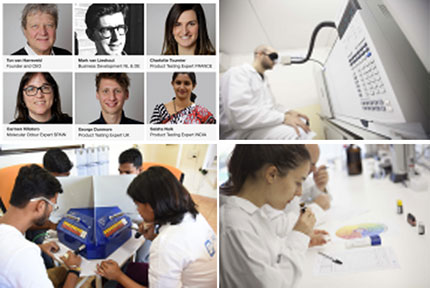|
Sensenet by Odournet: Offering odour evaluation services in India
|
|
By Rajal Shinkre
August 01 , 2019
|
|
|
It is a smelly world out there, be it the invigorating fragrance of the earth with the first rain or the heavenly aroma of freshly-brewed coffee, the heady fragrance of jasmine flowers, etc. (the smells that are associated with positive emotions and memories) or a stinking drain, a garbage dump or washroom malodour (which are some smells that one prefers to avoid).
It is largely the smell that drives a consumer to make his/her choice when it comes to purchasing personal, home care and hygiene products, and it is this consumer power that drives producers of consumer products to invest their resources in researching, developing and improving consumer products.
The experts at Sensenet know and have what it takes to make good smells better and remove bad smells.
The client question is the start of the Sensenet journey towards improving the sensory quality of your product or material.
Sensenet is a dedicated brand of the privately-funded, independent, part of Odournet Group, with origins in environmental odour assessment and managing odour nuisance since 1980.
Odournet and Sensenet have offices and laboratories in the United Kingdom, France, Spain, India and Brazil, with experienced sensory and molecular experts.
The Indian branch, Sensenet/Odournet India, the pioneering odour specialist company in India began operations in March 2013.
Today it has evolved into a full fledged facility, the first-of-its-kind in India, specialising in odour evaluation for improving the sensory experience of products and materials based on sensory evaluation.
Our state-of-the-art molecular odour evaluation laboratory, located in Barcelona, Spain, supports all Sensenet branches offering high-resolution GC-MS-TOF and GC-Sniffing services to unravel the molecular basis of odour.
Sensory and molecular analysis when undertaken together, provide a more complete picture to the clients about their product quality and performance.
With technological advancement, sophisticated instrumentation finds its way into research laboratories, offering sensitive analyses and quick analytical outcomes.
Hence, it is not uncommon to find potential clients exclaiming surprise when they learn that the nose is the instrument used to measure odour in sensory analysis.
Well, no analytical tool can replace the human nose completely; even the most sensitive and most recent instruments sometimes cannot detect odour molecules, while the human nose can detect a clear odour signal. For this reason, the standardisation of odour measurements is very important.
The Odournet Group has been a key player in developing odour measurement and standardisation of sensory measurements, such as the CEN standard EN13725 for olfactometry (Air Quality: Determination of Odour Concentration by Dynamic Olfactometry).
The standard also stipulates a robust method for selecting panellists, according to their olfactory acuity such that they are representative of 50 per cent of the average population, leading to reliable and reproducible odour measurement results.
Further training is imparted to the panellists so that they are able to assess different odour parameters, such as odour intensity and character, apart from odour concentration. Odour concentration measurement helps in providing more insights into product performance.
The odour concentration of a sample, measured in Odour Units (ouE/m3), can be determined by measuring the odour threshold concentration, which is defined as the concentration at which an odour molecule can be detected with a probability of 50 per cent.
For measuring odour threshold concentration, the method of olfactometry is used worldwide.
An olfactometer represents a measurement system, which dilutes odour samples with neutral air and presents them to a test panel for assessment.
Odour intensity can be assessed by using the VDI 3882 that allows the rating of intensity on a seven-category scale to determine the strength of an odour, while the measurement of hedonic tone, which can be performed at the same time, provides the assessment of how pleasant or unpleasant an odour is.
This can be done with trained expert panels or with representative panels, depending on the question to be answered.
Beside intensity and hedonic tone, it is also possible to describe odours by establishing a sensory description of the odour character of an olfactive signature.
It requires extensive training of expert panels prior to doing a sensory odour description.
Sensenet has developed an internal methodology to train panellists and assess odour description based on the use of 50 reference odour patterns from different chemical and smelling families.
Training and refresher training of the panels is an ongoing activity in all Sensenet branches as is the recruitment and screening of volunteers willing to offer their underarms as test fields or wear garments for in-context testing.
The Sensenet India laboratory works with a trained panel of 20 odour assessors and 200-plus consumer panel.
At the Sensenet India facility we can evaluate different odour parameters such as odour concentration, odour intensity, hedonic tone, acceptability, polarity profile, etc.
Malodour and VOC reduction performance testing, fragrance long-lasting effect, acceptance testing, benchmarking, etc. are some examples of the tests that can be carried out, according to recognised standards or as per customised test designs to answer specific questions of the clients.
A recent initiative, the Odour Threshold Shop aims to make standardised, reproducible odour threshold values (OTV) available to the odour research and fragrance and flavour community.
The almost 40 years of expertise in odour analysis, a deep understanding of both sensory and molecular perspective of odour along with the global knowledge available in local facilities, allows multicultural sensitivity, and puts Sensenet in a unique position in the odour business.
We evaluate and assess odours and other sensory attributes of products and materials from all sectors - perfumery, cosmetics, food, plastics, textiles, automotive, chemicals, pharmaceuticals. There is nothing smelly we cannot evaluate.
(The author is director, Odournet Holding India Pvt Ltd, Goa. She can be contacted at rshinkre@sensenet.net)

|
|



|
|
|
|
|
|
TOPICS
|
The Food and Drug Administration (FDA), Maharashtra, has issued a public advisory urging citizens to report any misleadi ...
|
|
|
|
|